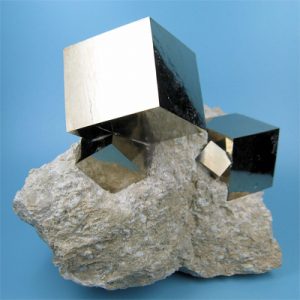Pyrite
Pyrite is also known as “Fool’s Gold” since is often mistaken for Gold. Pyrite is a very common mineral, the most abundant of all sulfide minerals. It is so common that it is found in almost every type of geologic environment and in a vast number of forms and varieties. Pyrite is a polymorph of Marcasite, which means that it has the chemistry, FeS2, as Marcasite; but a different structure and therefore different symmetry and crystal shapes. Its molecular weight is 119.98 gm. Pyrite has a specific gravity of 4.80 – 5.02 (g/cm3) and the refractive index of None Because its transparency is Opeque. Pyrite and Marcasite are often difficult to distinguish from one another due to their similar characteristics.
Marcasite is available from many localities worldwide.
| Category: | Sulfide mineral |
| Chemical Formula: | FeS2 |
| Molecular weight: | 119.98 gm |
| Crystallography: | Isometric – Diploidal |
| Crystal Habit: | Typically cubic, pyritohedral, octahedral, and combinations of these and other forms, to 25 cm or more. Striated conforming to pyritohedral symmetry; may be elongated to acicular. Commonly granular, globular, framboidal, stalactitic. |
| Twinning: | On [110], interpenetrating (Iron Cross Law). Twin axis [001] and twin plane [011], penetration and contact twins. |
| Cleavage: | [100] Poor, [110] Poor; partings on [011] and [111] |
| Fracture: | Conchoidal to Uneven |
| Tenacity: | Brittle |
| Hardness (Mohs): | 6.0 – 6.5 |
| Density: | 4.80 – 5.02 (g/cm3) |
| Luminescence: | None |
| Radioactivity: | Not Radioactive |
| Other: | Paramagnetic; a semiconductor. Magnetic after heating. Some fine-grained pyrite is metastable and may alter to melanterite, which contains sulfuric acid. Always wash hands after handling, especially decrepitated material. Avoid inhaling dust when handling or breaking. Never lick or ingest. |
| Color: | Pale Brass Yellow; tarnishes darker and iridescent |
| Transparency: | Opaque |
| Luster: | Metallic |
| Refractive Index: | None (opaque) |
| Birefringence: | None (opaque) |
| Dispersion: | None (opaque) |
| Pleochroism: | None |
| Anisotrophism: | Rarely |


